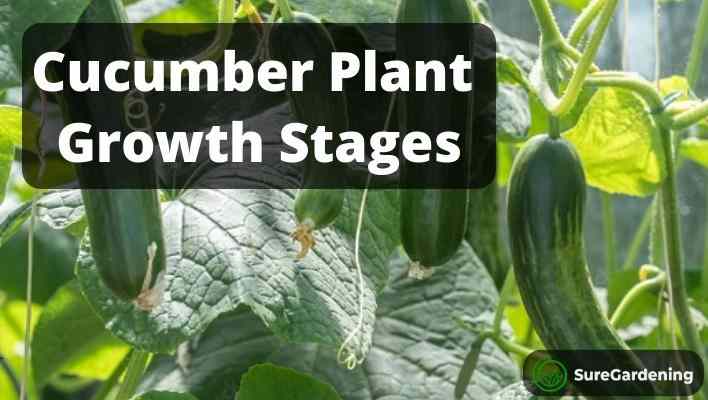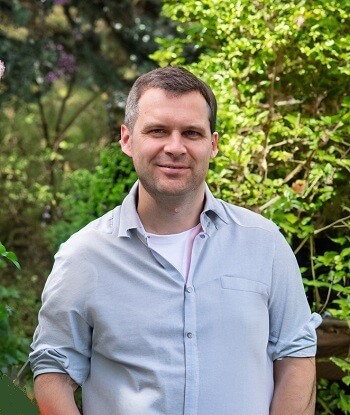Here you will find specific information about cucumber plant stages of growth that will enhance your gardening skills. Moreover, understanding these different growth stages that the cucumber plant goes through will help you identify any problems as it is growing.
For growing cucumber plants, the best time is the warm spring days after your last spring frost. Unlike cold-weather plants, they are warm-season plants. Additionally, they should be grown with companion plants.
Post Contents
Basic Information About Cucumbers:
Following is the table showing some important information about cucumbers.
| Property | Description |
|---|---|
| Name | Cucumber |
| Scientific Name | Cucumis sativus |
| Family | Cucurbitaceae |
| Origin | Likely originated in India |
| Shape | Cylindrical or elongated with a tapered end |
| Color | Green |
| Texture | Smooth skin with small bumps or ridges |
| Size | Typically 6-9 inches (15-23 cm) in length |
| Weight | Varies, usually between 6-12 ounces (170-340 grams) |
| Taste | Refreshing, crisp, and mild flavor |
| Nutritional Value | Low in calories, a good source of vitamin K and vitamin C |
| Growing Season | Warm season vegetable, commonly grown in summer |
| Storage | Best stored in the refrigerator to maintain freshness |
| Common Uses | Salads, sandwiches, pickles, juices, and as a garnish |
| Culinary Tips | Can be sliced, diced, or used in whole for various recipes |
Cucumber Plant Stages of Growth
Cucumber Plants go through several growth stages before fully grown and ready for harvesting. Every stage is important for the proper development and health of the plant. Usually, there are five main cucumber plant growth stages that are mentioned below:
- Seed sowing and Germination Stage
- Emergence of Seedlings
- Cucumber Flowering and Pollination Stage
- Fruiting Stage
- Harvesting Stage
Check out this Video guide:
All the stages are explained one by one below, from germination to harvesting the fruit:
1. Seed Sowing & Germination Stage:
The first stage of the cucumber plant is the seed sowing and germination stage. When you sow the seeds, it produces its first shoot and roots. Depending on temperatures, seeds germinate in 3 to 10 days.
However, germination usually occurs in three days when temperatures are warm, whereas cooler temperatures result in slower germination.
Adding here, seed germination of cucumber plants occurs fast, and you can notice a two-leaved seedling in under 10 days. That takes us to the next stage, the emergence of seedlings.
Related Article: 6 Radish Growth Stages: Life Cycle & Process
2. Emergence of Seedlings:
The seedling stage is the second stage of the cucumber plant life cycle. The first pair of immature leaves, called cotyledon, appear from the soil. Then, the plant’s true leaves develop, and it starts depending on photosynthesis for its nutrients.
Soon after, the vegetable develops more leaves, and vines grow longer. Now, at this time, plants need some attention and care. If growing cucumbers vertically, you should loosely attach each vine to a structure like a fence.
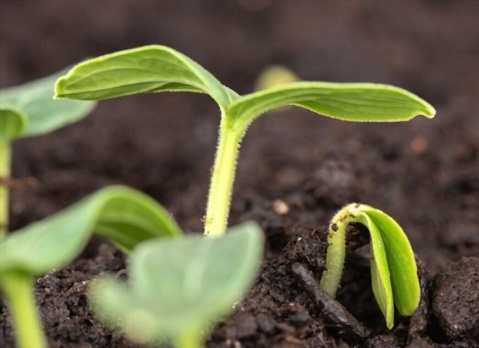
Then wait until the vines grow about 1 foot long and attach to the fence using loose ties that won’t cut or damage the soft, tender vines of the plant.
3. Cucumber Flowering & Pollination Stage:
The third out of 5 cucumber growth stages is Flowering & pollination stage. When cucumber plants mature, they majorly produce two kinds of bright, golden-yellow flowers: male and female, also known as staminate and pistillate. Male flowers emerge first, whereas female flowers emerge within one to two weeks.
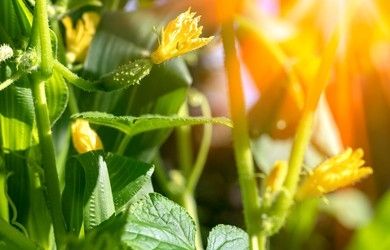
There is no self-pollination in cucumber plants, but bees or other pollinators are needed to carry pollen from male to female flowers. So this means that insecticides applied at the cucumbers’ flowering and pollination stage can kill the pollinators and ultimately harm the plant.
4. Fruiting Stage of Cucumber Plant:
Coming second last stage and equally important stage of cucumber plants is their Fruiting stage. When female cucumber flowers have been pollinated, they swell at their bottoms and start to develop into fruits successfully.
Cucumber fruits usually are ready 50 to 70 days after the seeds are sown. But their fruit depends on the variety and weather conditions. During this stage, it is crucial to water regularly and fertilize appropriately to help the fruit develop easily.
Related Article: Philodendron Rojo Congo Care Guide
5. Harvesting Stage of Cucumber Plant:
Out of five cucumber plant stages, the last one is fruit harvesting. Cucumber varieties used for making pickles are ready to harvest when the fruits reach 3 to 4 inches in length. The harvest typically lasts 7 to 10 days for each of those plants.
The fruits of varieties used for sliced eating are ready for harvest when they are 7 to 8 inches long, and their harvest time may continue for four to six weeks.
At peak harvest time, you should pick cucumber fruits every two days. Picking cucumber fruits regularly encourages cucumber plants to produce more fruit. Fruits on the vines become bitter, and their skins turn tough, eventually making the fruit unusable.
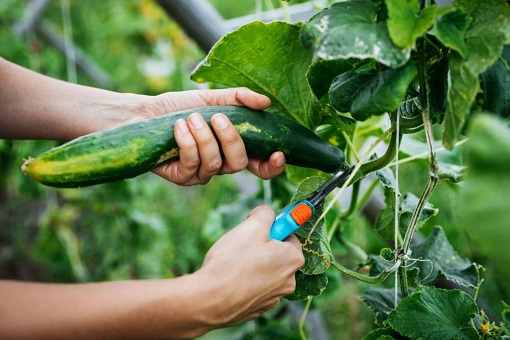
A mature cucumber plant generally produces about 5 pounds of fruits. Cucumbers need to be picked on time for a plant to produce as much as possible. You should pick cucumbers while they are immature.
When a cucumber fully matures on the vine, it will send signals to the rest of the plant that will start slowing down the production of cucumbers. This will lead to fewer cucumber yields.
You can better know the right size to pick cucumbers by knowing about the variety you’re growing.
Related: 4 Broccoli Growth Stages: (Unlocking the Secrets)
Types of Cucumbers:
Cucumbers hold significant importance in culinary traditions worldwide. They are used in salads, sandwiches, pickles, and various recipes, adding a crisp and refreshing element to dishes. Additionally, cucumbers are a popular choice for home gardeners due to their relatively easy cultivation, making them a staple in many backyard gardens.
There are several common varieties of cucumbers, each with its own unique characteristics and culinary applications. Let’s explore some of the most popular types:
1. Slicing Cucumbers
Slicing cucumbers are the most commonly consumed cucumbers. They are usually large in size, with a thick skin and a firm, crunchy flesh. The skin of slicing cucumbers is often waxed to prolong shelf life.
2. Pickling Cucumbers
Pickling cucumbers are specifically grown for pickling purposes. They are smaller in size compared to slicing cucumbers and have a bumpy or warty exterior. The flesh of pickling cucumbers is crisp and ideal for absorbing pickling brine.
3. Seedless/English Cucumbers
Seedless or English cucumbers are elongated and slender in shape. They have a thinner skin, fewer seeds, and a sweeter taste compared to other cucumber varieties. Seedless cucumbers are commonly used in salads and sandwiches.
Moving on to specialty varieties of cucumbers, these offer unique flavors and characteristics that cater to specific culinary preferences:
4. Armenian Cucumbers
Armenian cucumbers, also known as snake melons, have a thin, light green skin and a length that can exceed a foot. They have a mild, slightly sweet flavor and a crunchy texture. Armenian cucumbers are often used in salads, soups, and stir-fries.
5. Lemon Cucumbers
Lemon cucumbers are small, round cucumbers that resemble lemons in shape and color. They have a mild and slightly tangy flavor. Lemon cucumbers are popular for their refreshing taste and are often enjoyed fresh in salads or used as a decorative garnish.
6. Persian Cucumbers
Persian cucumbers are shorter and plumper than English cucumbers. They have a thin, tender skin and a crunchy texture. Persian cucumbers are commonly used in Mediterranean and Middle Eastern cuisines, particularly in salads and yogurt-based dips.
7. Miniature/Gherkin Cucumbers
Miniature or gherkin cucumbers are tiny cucumbers, typically measuring around 2 to 4 inches in length. They have a bumpy skin and a crunchy texture. These cucumbers are primarily used for pickling due to their small size and ability to retain crunchiness.
In addition to the well-known cucumber varieties, there are also lesser-known types that offer unique flavors and culinary applications:
8. Long English Cucumbers
Long English cucumbers are similar to seedless cucumbers but are longer in length. They have a thin skin, few seeds, and a mild taste. Long English cucumbers are often used in salads, sandwiches, and as a fresh snack.
9. Japanese Cucumbers
Japanese cucumbers, also known as kyuri, are slender and have a dark green skin with fine ridges. They have a crisp texture and a slightly sweet taste. Japanese cucumbers are commonly used in Japanese cuisine, including sushi rolls, salads, and sunomono (cucumber salad).
10. Indian Cucumbers
Indian cucumbers come in various shapes and sizes, including round, oval, and ridged varieties. They have a crunchy texture and a slightly bitter taste. Indian cucumbers are commonly used in Indian curries, raita (yogurt-based condiment), and chutneys.
Vining vs. Bush Types of Cucumber Plants:
All varieties of cucumbers either grow by producing long vines or have a bushier habit of growth by producing short vines.
Vining cucumber plants are usually large and sprawling, requiring a large area to spread for proper growth. Some varieties can produce up to 10 feet long, although the growth of 5 to 6 feet long vines is typical.
Vining types work well growing vertically on a structure like a fence. Approximately 5 feet should be the distance between seeds or hills when planting multiple vining types.
On the other hand, bush types don’t produce the long vines that vining types do, making them good choices for potted growth. Bush varieties are suitable for those lacking garden space or wanting something smaller and easier to care for.
Bush varieties also produce fruits earlier than vining types. The distance between them should be about 2 feet.
Frequently Asked Questions
How Long Does It Take the plants to produce fruits?
Usually for a cucumber plant it takes almost 55 to 70 days after germination to produce fruit that is ready to harvest. Whereas, in cooler weathers, the plants grow slowly and reach production later.
What is the time period between flowering and fruit?
The first female flowers will appear within 42 to 62 days after planting. After that, it will take 10 days to produce fruit.
When To Harvest the Cucumbers?
Harvest your cucumbers when they reach the desired size. This is 3 – 4 inches for cucumbers which will be used for pickles, and 7 – 8 inches for slicing cucumbers.
Will cucumbers go bad if not harvested in time?
Cucumbers left on the plant for too long develop a bitter taste that ruins the fresh crisp flavor. The fruits get ripened at different times on the plant, so it is important to pick them when they are ready.
What is the age of Cucumber Plants?
Cucumber plants are a yearly plant, this means that if the plant has given fruit and has lived the growing season it will not regenerate. The life span is roughly of 70 days, after this the plant dies and cannot be regrown.
Conclusion
Cucumbers are a delight for everyone and are used in many different ways worldwide. Depending on the variety, you can use them for pickling or slicing. The slices are well served by themselves or with a sauce or can be combined with other greens to make salads.
Cucumber plants and Cucumbers are very versatile, and they are really easy to grow. I hope you have gained all the necessary information about cucumber plant stages and how to grow and care for them.
You Can Also Read Some Related Articles:
